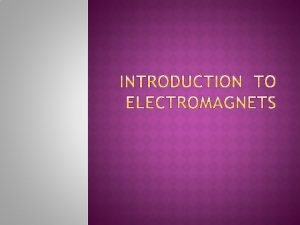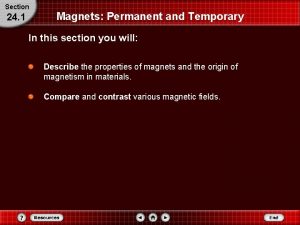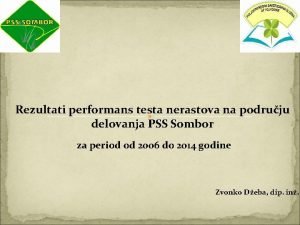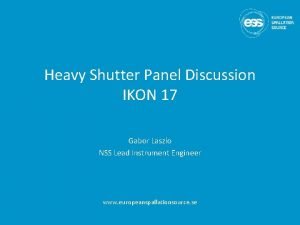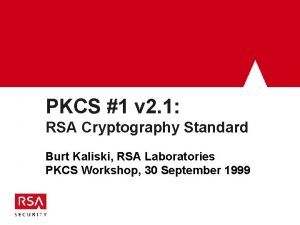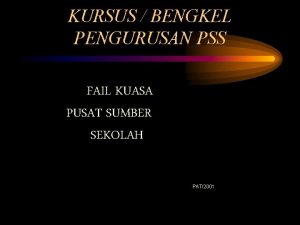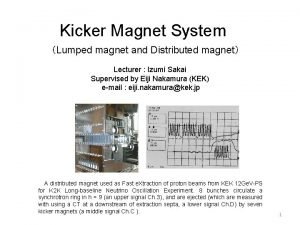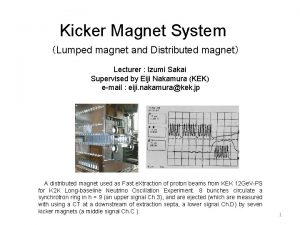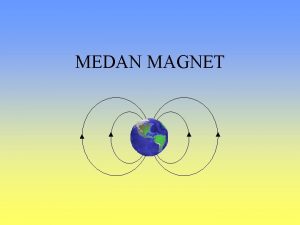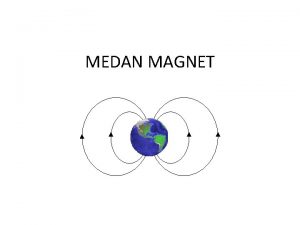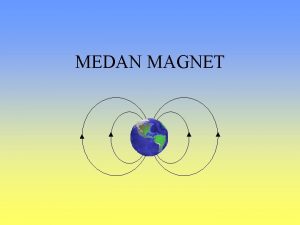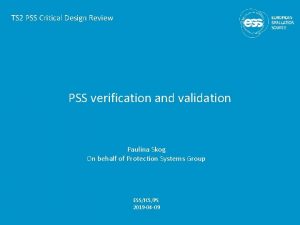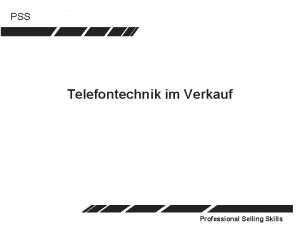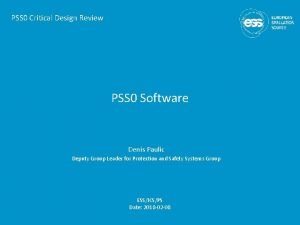PSS Kicker Magnet for 200 Ke V Upgrade













- Slides: 13

PSS Kicker Magnet for 200 Ke. V Upgrade: Conceptual Magnetic Design and Analysis Results (V 02) Lakshmi

Contents • Design Requirements (updated list of parameters) • Assumptions (same as the previous design analysis V 01) • Magnetic Design -Coil geometry, physical dimensions -Conductor choice • Magnetic Analysis Results • Summary • Next Steps… PSS Kicker Magnet Conceptual Design Analysis-V 02 2

Magnet Performance Requirements • The PSS kicker magnet deflects the beam onto the “A 2” mask in the injector beamline. Parameter Unit Central gap (to accommodate beam pipe) (requirement) mm 19. 05 Distance from the center of the magnet assembly to the center of the A 2 mask (requirement) cm 33. 7*** Max. deflection height (for design calculations) cm 1 Nominal energy of the electron beam Ke. V 200 Magnetic rigidity of the beam particles T. m 1. 649× 10 -3 Max. deflection angle of the beam particle (horizontal/ vertical kick) radians 0. 030 Integrated field strength along the longitudinal axis (Z-axis) of the magnet (requirement) T. m 4. 894× 10 -5 Maximum supply current to the coils (current capacity of the PSS relay) m. A 500*** ** Magnet homogeneity requirements: Unspecified *** Revised specification PSS Kicker Magnet Conceptual Design Analysis-V 02 3 Value

Assumptions made for the Magnetic Design Calculations • The conceptual design uses solid model for coils. The solid model accounts for the optimum lay out of the copper conductor to allow a compact bifilar winding pack meeting the performance requirements for the kicker magnet. -Previous calculations (V 01) suggest that bifilar coils in racetrack geometry provides an optimum configuration for the magnet assembly. • Central gap of the magnet assembly provides the space to install beam pipe and the support structure for the horizontal and vertical coil assemblies. • Copper coils are air-cooled. • No magnetic materials are allowed in the magnet assembly. • Allow a reasonable operating current margin for the (coils) control relay. • The kick windings are not sensitive to the magnetic field generated in the bias windings in any fault scenario (no electromagnetic coupling). • The fringe field of the neighboring coil assemblies have no impact on the kicker magnet performance. • The overall field homogeneity requirements: unspecified. PSS Kicker Magnet Conceptual Design Analysis-V 02 4

Design Considerations: Layout of Bifilar Coils (New Config. ) in the Magnet Assembly (In the new config. reduced the gap between the opposite coils from 64 mm in V 01 to 54 mm (V 02, option 1)) Coil support structure Coil (bobbin between top and Bottom plates) • Four identical bifilar coils in racetrack geometry -The vertical coil assembly (upper+lower coils) and the horizontal coil assembly (right+left coils) are energized using two separate (identical) power supplies. -The kick and bias windings in each bifilar coil form a parallel electrical circuit, whereas the upper and lower or left and right bifilar coil windings are connected in series. upper • The coils are arranged symmetrically around the beam pipe. -Magnet support structure (Material: G-10 or Stainless steel) consists of four (diagonally cut, at round corners) pieces. These components are assembled together using mechanical fasteners right left • The central opening (diameter-38. 1 mm) is to accommodate the beam pipe -The inner shell of the magnet support structure is made of an insulating material (suggestion) • Minimizes the electromagnetic coupling to the beam pipe lower Inner shell of the Support structure support structure For mag. assembly Note: Not all components of the support structure are shown. PSS Kicker Magnet Conceptual Design Analysis-V 02 5 • The coil support structure (base plate, top plate and bobbin) is made of insulating material (suggestion)

Design Considerations : Copper Conductor (Magnet Wire) Geometry • Preferred geometry: Square conductor with round corners -Offers a better packing fraction compared to the round conductor compact coil. -Simplifies the bifilar winding process -Use commercially available insulated Multi-filar magnet wire c a a- bare copper conductor b-insulation wrap c- epoxy filling ( when used in the coil) b Conductor cross section Magnet wire parameters (Max. dimensions) Unit Shape Square with round corners Benefits: one feed reel is required for coil winding; Simplifies the tooling requirement compared to that of using round conductor Copper grade • Bare square conductor dimensions: • current density in the coil windings are within the recommended range for the air Radial thickness of epoxy filling -cooled copper coils (< 2 A/mm 2 (upper Overall width (=height) of the conductor limit)) PSS Kicker Magnet Conceptual Design Analysis-V 02 C 101 or C 102 Bare conductor size (equivalent AWG) -Coil design (results presented in this file) Bare conductor width (= height) is optimized for the use of AWG 22 equivalent square conductor with round Corner radius corners. Radial thickness of insulation wrap 6 Value 22 mm 0. 729 mm 0. 127 mm 0. 0178 mm 0. 0127 mm 0. 790

Racetrack Coil Parameters for the Magnet Assembly Option 1 • Presented two options for the coil layout in the magnet assembly Racetrack bifilar coil parameters (for the optimized geometry) (using the max. dimensions of the conductor) Unit Coil layout in the magnet assembly Value Option 1 (preferred) Distance between the opposite coils in the kicker magnet assembly mm 54 Overall dimensions of the magnet wire used in the bifilar windings mm 0. 790 Inner gap (radial) of the bifilar coil mm 20 Radial thickness, and height of the bifilar coil mm 14. 219, 15. 799 Inner corner radius of the bifilar winding mm 3 Straight length, and overall length of the bifilar coil mm 35, 69. 438 Total turn counts in the bifilar coil 360 Number of layers of winding, Number of turns per layer in the bifilar coil 18, 20 Turn count in the bias /kicker windings in the bifilar coil 180/180 Estimated length of conductor per bifilar coil (+50 cm for each lead wire) m 60. 15 Req. length of conductor for kicker magnet (four bifilar coils+ lead wires) m 240. 6 PSS Kicker Magnet Conceptual Design Analysis-V 02 7

Racetrack Coil Parameters for the Magnet Assembly Option 2 • Presented two options for the coil layout in the magnet assembly Racetrack bifilar coil parameters (for the optimized geometry) (using the max. dimensions of the conductor) Unit Coil layout in the magnet assembly Value Option 2 Distance between the opposite coils in the kicker magnet assembly mm 56 Overall dimensions of the magnet wire used in the bifilar windings mm 0. 790 Inner gap (radial) of the bifilar coil mm 20 Radial thickness, and height of the bifilar coil mm 14. 219, 17. 379 Inner corner radius of the bifilar winding mm 3 Straight length, and overall length of the bifilar coil mm 35, 69. 438 Total turn counts in the bifilar coil 396 Number of layers of winding, Number of turns per layer in the bifilar coil 18, 22 Turn count in the bias /kicker windings in the bifilar coil 198, 198 Estimated length of conductor per bifilar coil (+50 cm for each lead wire) m 65. 96 Req. length of conductor for kicker magnet (four bifilar coils+ lead wires) m 263. 84 PSS Kicker Magnet Conceptual Design Analysis-V 02 8

Magnetic Performance Parameters (Fault scenario: Only the bias windings are energized ) • A comparison of performance of magnet with two types of coil geometries (Option 1 and 2) Parameter ( Note : all the listed parameters are at Imax-coil) Unit Coil layout in the magnet assembly Value Option 1 Distance between upper-lower/ left-right bifilar coil packs mm Option 2 54 56 4. 90× 10 -5 m. A 455 446 A/mm 2 0. 88 0. 86 Magnetic field strength at the center of the magnet m. T 0. 756 0. 742 Max. field strength on the bifilar coil m. T 3. 46 3. 54 Effective magnetic length of the dipole bifilar assembly (Vertical / horizontal) mm 64. 8 65. 9 Cumulative strength of Lorentz forces on the bifilar coil pack m. N 0. 342 Magnetic Stored Energy of the dipole assembly µJ 293. 4 328. 8 Self inductance of the kick/ bias windings in the bifilar coil m. H 1. 37 1. 6 1 1. 1 Integrated field strength along the longitudinal axis (Z-axis) of the dipole bifilar assembly ( Vertical/ Horizontal) (required: 4. 894× 10 -5 T. m) Operating current (Imax-coil) Current density in the copper conductor Resistance of the kick/ bias windings in the bifilar coil PSS Kicker Magnet Conceptual Design Analysis-V 02 9

Magnetic Field Distribution in the Vertical Dipole Coil Assemblies (Option 1) (Fault scenario: Only the bias windings are energized at 455 m. A) 455 m. A PSS Kicker Magnet Conceptual Design Analysis-V 02 10

Magnetic Field Distribution in the Vertical (XY) Plane (at Z=0) (Fault scenario: Only the bias windings are energized at 455 m. A) Vertical Dipole Coil Assembly ( Magnet Coil layout : Option 1) 455 m. A PSS Kicker Magnet Conceptual Design Analysis-V 02 11

Mag. Field Profile Along the Long. Axis (Vert. Dipole with Racetrack coils Fault Scenario: only bias windings are energized at at 455 m. A) • Co-ordinates: X=0, Y=0, Z= 350 mm from the magnet center PSS Kicker Magnet Conceptual Design Analysis-V 02 12

Summary • Two design variations (Option 1 and Option 2) are presented. Option 1 is preferred. -Meets the physics, design and performance requirements. -Offers compact geometry -Square conductor simplifies the tooling and coil winding process. -Offers reasonable operating current margin. • Design option 1 is chosen for the PSS kicker magnet (04/29) • Next Plans -Verify the calculations to support the electrical integration of the magnet assembly (Jerry+ Lakshmi) • The data presented in this document gives a good starting point. -2 D (initial plan) sub-modelling (with conductor layout in bifilar geometry) is required to verify the electromagnetic coupling effects between the kick and bias windings (Lakshmi) • For the final coil geometry (after discussing the magnetic design/ analysis results with the team). • Needs the detailed coil model. -Already developed the mechanical assembly concept model (Lakshmi). Main focus so far was to verify the space allocation consistent with the magnetic design requirements). • Need ME assistance to further detail the solid coil model with conductor layout and mechanical assembly -Provide the conductor layout info to assist ME to detail the coil pack and the mechanical assembly (Lakshmi), electrical termination of the magnet assembly (Lakshmi, Jerry) and work with ME to complete the design package. PSS Kicker Magnet Conceptual Design Analysis-V 02 13

